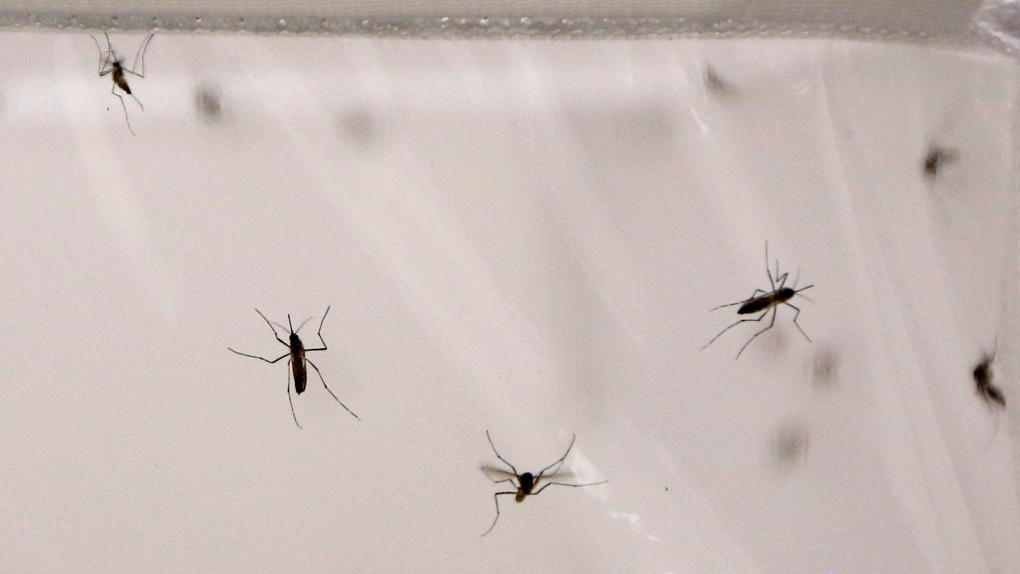Midges are back. Here’s what they are, and why they matter
 Mosquitoes are seen inside a stock cage in a mosquito labaratory at the London School of Hygiene and Tropical Medicine in London, Thursday, May 30, 2013. Little black mosquito-like insects called midges have descended on the city. (AP Photo/Sang Tan)
Mosquitoes are seen inside a stock cage in a mosquito labaratory at the London School of Hygiene and Tropical Medicine in London, Thursday, May 30, 2013. Little black mosquito-like insects called midges have descended on the city. (AP Photo/Sang Tan)
It’s almost that time of year again, when going for a walk on a sunny day might just mean walking into a swarm of black gnats.
These gnats, known as midges, are often found in Ontario's lakeshore, wildlife areas and parks. Most years, they began to appear in early springtime and last throughout the summer before dying in the fall.
Doug Currie, a professor in the Department of Ecology and Evolutionary Biology at the University of Toronto, said they’re a small price to pay for a healthy ecosystem.
“Just think, if they were to disappear, that would be a warning that things aren’t quite that great,” Currie said about the bugs on and near Lake Ontario. “So I think that given what a short period that they’re out, is a small price to pay for a clean lake.”
That’s because midges can tell us a lot about our ecosystems. Midges, when highly populated above bodies of water, are an indication of healthy water with regular oxygen levels. When absent, they point to pollution in the water.
In addition, adult midges get eaten by larger insects such as spiders and swallows.
Monthly, in the spring and summertime, new species of these bugs will appear. There are over 4,000 species, all of which emerge in swarms as a way of mating.
“When you get these large swarms, it’s actually a mating ritual,” Currie said. “And so they need to connect with each other to mate.”
The large swarms are usually male midges that group together to attract females. After mating, Currie says that the cycle begins again.
“[They’ll] go off and mate, and then the cycle begins again. [They lay] their eggs on the lake or the street, and then the cycle begins again.”
Most of the species seen in Ontario do not bite, however the ones that do are females as they need protein to mature their eggs.
Currie says that they do not bite, and that there isn’t a surefire repellent against them.
“They’re certainly innocuous creatures,” he said
CTVNews.ca Top Stories

'We're not the bad boy': Charity pushes back on claims made by 101-year-old widow in $40M will dispute
Centenarian Mary McEachern says she knew what her husband wanted when he died. The problem is, his will says otherwise.
Trump names fossil fuel executive Chris Wright as energy secretary
U.S. President-elect Donald Trump has selected Chris Wright, a campaign donor and fossil fuel executive, to serve as energy secretary in his upcoming, second administration.
'A wake-up call': Union voices safety concerns after student nurse stabbed at Vancouver hospital
The BC Nurses Union is calling for change after a student nurse was stabbed by a patient at Vancouver General Hospital Thursday.
Montreal city councillors table motion to declare state of emergency on homelessness
A pair of independent Montreal city councillors have tabled a motion to get the city to declare a state of emergency on homelessness next week.
'The Bear' has a mirror image: Chicago crowns lookalike winner for show's star Jeremy Allen White
More than 50 contestants turned out Saturday in a Chicago park to compete in a lookalike contest vying to portray actor Jeremy Allen White, star of the Chicago-based television series 'The Bear.'
WestJet passengers can submit claims now in $12.5M class-action case over baggage fees
Some travellers who checked baggage on certain WestJet flights between 2014 and 2019 may now claim their share of a class-action settlement approved by the British Columbia Supreme Court last month and valued at $12.5 million.
NYC politicians call on Whoopi Goldberg to apologize for saying bakery denied order over politics
New York City politicians are calling on Whoopi Goldberg to apologize for suggesting that a local bakery declined a birthday order because of politics.
King Arthur left an ancient trail across Britain. Experts say it offers clues about the truth behind the myth
King Arthur, a figure so imbued with beauty and potential that even across the pond, JFK's presidency was referred to as Camelot — Arthur’s mythical court. But was there a real man behind the myth? Or is he just our platonic ideal of a hero — a respectful king, in today's parlance?
Former soldier 'Canadian Dave' taken by the Taliban: sources
David Lavery, a former Canadian Forces soldier who helped approximately 100 people flee Afghanistan during the fall of Kabul, has been 'picked up' by the Taliban this week, according to multiple sources who spoke to CTV National News on the condition of anonymity.































